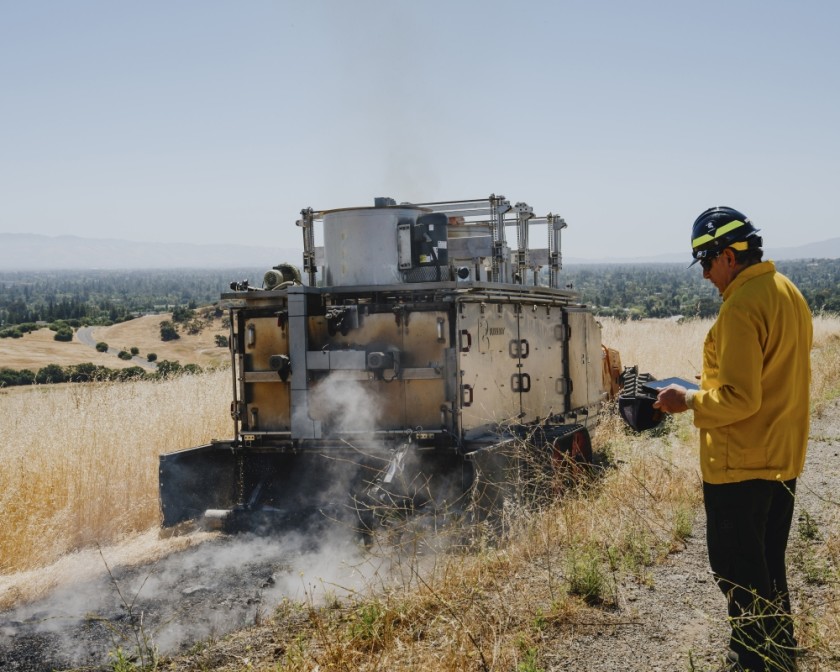

This is the tinderbox of the Sierra Nevada. It’s early June, the temperature is 97 degrees Fahrenheit and the air shimmers over dead trees choked in brush. In the Stanislaus National Forest, logging roads wind through firs and ponderosa pines, past 20-foot-tall burn piles — tons of scrap wood not worth bringing to a sawmill. They’ve been assembled by workers on the front line of the fight against forest fires: a timber crew thinning these woods for the Forest Service and a tech startup that’s trying to automate the enormous machines the crew relies on.
They are called skidders: 10-foot-tall vehicles on four massive wheels, with a bulldozerlike blade on the front and a tree-size grapple dangling from the back. They are the worker bees, hauling downed logs from the forest to landing sites, where they are delimbed and loaded onto trucks bound for the sawmill. Usually, a single driver operates them for a 12-hour shift, grabbing logs from behind and then driving forward.
Engineers at the Sonora, California, startup Kodama Systems, a forest management company, have hacked into a skidder built by Caterpillar, studded it with cameras and radar, and plugged it into the internet. The result is a remote-controlled machine that does scut work for a timber crew and teaches itself to operate semiautonomously, using lidar — or light detection and ranging — to map the forest.

Kodama has raised $6.6 million for a business that is driven by the reality that much of our forestland these days is stuffed with fuel just waiting to ignite. A few hundred miles from Stanislaus, a man drove a flaming car into a ditch in early August and started the Park fire, which burned an area larger than Los Angeles.
What happens if you set a region full of technology entrepreneurs and investors on fire? They start companies. Dozens of startups, backed by climate-minded investors with more than $200 million in capital, are developing technology designed to tackle a fundamental challenge of the warming world.
For years the response to wildfires was simple: Put them out. But this strategy has unnaturally stockpiled biomass — a catchall term for trees, brush and grass — in California forests. In recent decades, foresters and firefighters have realized that battling wildfires requires “treating” their fuel in advance: thinning forests and underbrush with mechanical tools and controlled — or prescribed — burns, a practice long advocated by Indigenous communities.
There’s just one problem: “There aren’t enough hands,” said Kate Dargan, a former CalFire chief and entrepreneur who now works on wildfire resilience for the Gordon and Betty Moore Foundation. “This is not a high-paying industry, it’s a hot, dirty, hard industry ... where technology can help assist human production capability, it’s really important.”
If Kodama’s vehicles work as planned, they could multiply existing efforts. The near-term plan is to allow one operator to drive two skidders at once, and to run a second shift at night. In June, Jenkins showed how to operate the skidder from an employee’s home miles from the logging site; weeks later, he said he ran it from London.
On another hot June afternoon, a different robot is torching grasslands near a giant satellite dish on the Palo Alto campus of Stanford University. Four certified wildland firefighters operate BurnBot, perhaps best described as a giant, upside-down propane grill: Inside a metal box on treads, a dozen jets blast flames at the ground, generating temperatures near 500 degrees Fahrenheit.
An autonomous tractor pulls the box steadily along the hillside, leaving behind the smell of cap guns and a 5-foot ribbon of charred ground, pounded flat by the machine’s cylindrical dampers and steaming from a steady spray of water. Alongside a highway, this protective line could prevent ignition caused by passing cars; checkerboarding a large stretch of land, it could allow for controlled burns that normally require dozens or hundreds of people and ideal weather conditions.
Oman Observer is now on the WhatsApp channel. Click here


